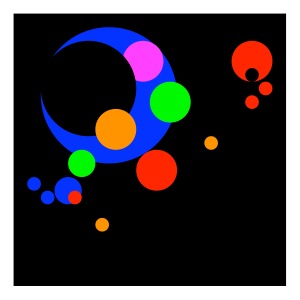What is art? Something that makes us feel an emotion? An appealing way of arranging materials? Deviations from convention? Something that’s pleasing to the eye? Whatever it is there are some more intriguing questions when we mix art and computer science. Can a computer create art, for example? What happens when artists learn some computer science and mix it with their art? Could a computer-created picture ever be called a work of art?
How ever you define it, creating an emotionally or intellectually engaging work of art requires innovation, creativity and imagination. It turns out that those qualities of an artist are good qualities for a computer scientist to have too. They help us to come up with new ways of doing things, or new things to do. Thinking like an artist can lead to new forms of engagement both with computers and even between humans.
Artists with computer science skills are very special people.
Activity Sheets and Booklets
The following activities draw out issues on the links between language, linguistics and computer science.
- Pixel Puzzles
- Understand how computers store and display images through colour-by-numbers art. Explore links to impressionism and post-impressionism
- Algorithmic Doodle Art
- Follow simple algorithms to draw pictures reminiscent of nature. Explore how computer science artists device algorithms to create computer generated scenery.
- Maritime Signal Flags
- Learn about how to communicate with flags and how to write programs to draw them.
- Hexaflexagon Automata
- Make hexaflexagons and draw images on the sides to create a piece of art where the images magically come and go – all on a piece of paper.
- The Teleporting Robot
- This picture is a baffling magic trick. Move the jigsaw pieces around and a robot disappears from the picture. Follow the algorithm of how to draw the magic and draw your own pictures where objects magically disappear.
- Mosaics, the Romans and digital images
- The Romans knew all about raster graphics, pixels and high resolution images. They called them mosaics.
- Vector Drawing Puzzles
- Draw images by following instructions and combine maths, computing and art. Explore the basics of CGI (computer generated imagery).
- Vector-dot-to-dot drawing puzzles
- Draw images by plotting the dots, then joining them. Explore polygons in SVG.
Artists and Styles
William Morris and drawing nature-based recursive art
- Use recursive doodle algorithms to generate natural looking imagery with a William Morris flavour.
Mondrian and Image Representation
- Create Mondrian-inspired abstract art and see how images can be represented by a program that draws them.
Seurat and Pointillism
- Explore pointillism through pixel puzzles. Learn about bitmap graphics.
Kandinsky and abstract art
- Draw Kandinsky-inspired abstract art by following then creating instructions to place shapes. Learn about vector graphics.
Bridget Riley and perception
- Draw pictures that play with your perception while learning about programs.

Magazines to download
The following magazines include articles that draw on the links between English and computing.
- Computer Science and the Image: Issue 7 of cs4fn Magazine
- In this issue we look at how computer science helps art, how artists work with computer science and how computer scientists work with images.
- Creative Computing: Issue 22 of cs4fn Magazine
- In this issue we look at how computers can be creative, support creativity and provide new medium for art. Several articles explore generative art.
cs4fn subject portal
There are lots of fun articles on the cs4fn about computer science, art and images. See the portal:
Other resources
- Manchester University for many years ran an annual animation competition. Combine programming, art, film-making and storytelling skills, to program a short animation. It no longer runs but you can see past animation winners following the links from their site here. [EXTERNAL]




